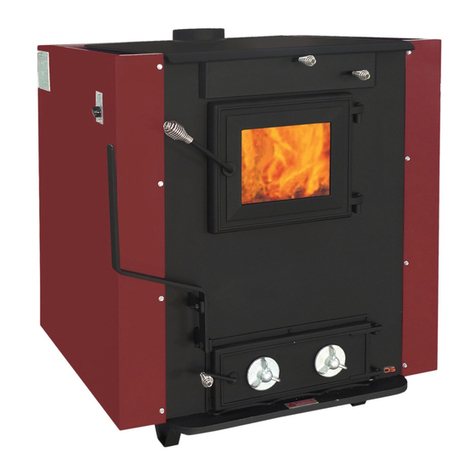
horizontal) and not more than two bends. No reduction in flue pipe below the exhaust diameter
should be used. The pipe connecting the furnace to the chimney should be at least 24 gauge.
Thicker gauges are available and will resist corrosion longer
and need fewer replacements. Slope the flue pipe back
towards the heater, 1/4” per foot of horizontal run. That way
if any condensation forms in the pipe it will be carried back
into the heater. The connector pipe should be installed so
that the upper pipe section fits inside the lower section. This
way any condensation building up inside the pipe will stay
inside the pipe as it flows down the inside surface.
Horizontal pipe runs should have the pipe seams turned up
Particular attention should be paid
to the point where the flue passes
through a wall or ceiling. This pen-
etration should always be made
with a thimble, insulated pipe, and
then proper accessories following
manufacturers instructions.
Chimney connectors must not
pass through the ceiling,
concealed spaces, or enter the chimney in the attic, unless
proper clearance or insulated pipe is used following manufac-
turers instructions. REMEMBER that all single wall chimney
connector sections
should be connected
with at least 3 sheet
metal screws per joint.
A fire in the stack may
cause vibration and poorly fastened piping may come apart causing an extreme fire and smoke
hazard. Do not extend single wall chimney connector past the inside edge of the flue liner. f you
have a manufactured stainless steel chimney, attach single wall chimney connector to single wall
chimney connector adapter. Where the pipe connects to a masonry chimney, the flue to the chimney
should be larger than the single wall chimney connector so you can insert the pipe out to the inside
edge of the chimney, but not past. Then seal as tight as possible and cover with a trim collar.
3
Chimney Requirements
Use an 8” Class “A” approved chimney. Refer to manufacture’s instructions.
The minimum height of a chimney system for the D.S. Furnace
is 20 feet. The chimney must exceed the roof of a house at a
minimum of 3 feet at any point of exit. n a pitched roof installation
the chimney must be 2 feet higher than anything within a 10 foot
radius of the chimney. t is important to have a chimney draft of
-0.06 water column. t is required to abide by the manufacturer’s
instructions on Class A chimneys as well as local building codes.
t is not recommended to build a chimney on an addition that is
lower than the main part of your house. Do Not extend the single
wall chimney connector past the inside of a masonry chimney
liner. Never connect this unit to a chimney serving
another appliance.
Should you have a problem with inadequate draft
you should see page 15.
Minimum Clearance to Combustibles
Control side to comb stibles 21”
A ger side to comb stibles 12”
Back to comb stibles w/single wall stove pipe 30”
Back to comb stibles w/do ble wall stove pipe 18”
Top to comb stibles 18”
Front to comb stibles 36”
Single wall stove pipe to comb stibles 18”
Do ble wall stove pipe to comb stibles 6”
Top of plen m to ceiling 2”
Barometric
Draft
Control
CAUTION:
Keep furnishings and other combustible
materials away from the boiler.
Floor Protection
8” on back & 2 sides, 16” on front
Fig.1
A - Optional Control Box
Location
B - Limit Switch
C - Hot Air Outlet
D - 8” Exhaust
E - Cold Air eturn Box
8” 8”
Top View
Front
of Furnace
30”
12”
see
below*
12”
see
below*
36”
A
A
B
C
D
E




























